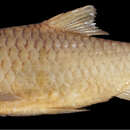Description
(
İngilizce
)
Zookeys tarafından sağlandı
Specimens from Rūdkhāneh-ye Naband basin were excluded from this species description (see below).
The dorsal profile is convex up to the origin of the dorsal fin and a nuchal hump is present in specimens longer than about 100 mm SL. This species has a high back and caudal peduncle (Figs 23, 24). The ventral profile of the head is convex, its dorsal profile is almost straight to convex and has a hump near the nostrils in juvenile specimens. The mouth is sub-terminal. The barbels are short and stout. The maximum body depth is usually greater than the head length (Fig. 12). Usually one pair of barbels is present, but about 10 % of the specimens have two pairs of barbels (Table 2). The eyes are at the back of the anterior half of the head. They are big and slightly protuberant. The morphometric characters are summarised in Table 1.
The dorsal fin usually has four unbranched and eight to 11 branched rays (Table 3). In specimens from the Tigris-Euphrates drainage system the last unbranched ray of the dorsal fin is strong with only the tip being flexible and it is about as long as the head. It is shorter and less ossified in Iranian populations (Fig. 4). The anal fin usually has three unbranched rays and five to seven branched rays (Table 4).
There are 25 to 33 scales in the lateral line (Table 5), 3.5 to 6 scales above the lateral line (Table 6), 3 to 5.5 scales below the lateral line (Table 7) and 10 to 13 scales around the least circumference of the caudal peduncle (Table 8). The scales are shown in Fig. 5.
The pharyngeal teeth count is 2.3.5-5.3.2 in 26 specimens, 2.3.4-5.3.2 in two specimens, 2.3.5-4.3.2 in one specimen, 2.3.5-5.3.3 in one specimen, 1.3.5-5.3.2 in one specimen, 2.3.5- in one specimen and 2.3.4- in one specimen. The pharyngeal teeth are hooked at their tips (Fig. 6).
Live specimens are silvery to olive and sometimes have yellowish fins (Fig. 24). Ethanol-preserved specimens are light yellowish brown to grey. In most cases the back is darker than the rest of the body. Some of the lighter coloured specimens have a salmon hue, others are silvery. The fins are yellowish brown to grey. Juveniles have a dark spot on the sides of the caudal peduncle.
Carasobarbus luteus from Ḩelleh, Kol, Mahārlū and Mand populations: The last unbranched ray of the dorsal fin is shorter and less well ossified. It is pronouncedly shorter than the head (Fig. 4). The mouth is wider and the body is not as high-backed as in specimens from the Tigris-Euphrates system (Fig. 12).
Carasobarbus luteus from Rūdkhāneh-ye Naband basin: In this population all specimens examined had two pairs of barbels (Table 2). The anterior pair is longer than in specimens from Tigris-Euphrates system with two pairs. The last unbranched ray in the dorsal fin is considerably shorter than the head (Fig. 4) and comparatively weak. Compared with specimens from Tigris-Euphrates system, the dorsal and ventral fins tend to be slightly further away from the head. The head is longer and the body not as high backed as in specimens from Tigris-Euphrates system (Fig. 12). The general body shape (Fig. 25) resembles that of Carasobarbus apoensis and Carasobarbus canis. Some of the gill rakers are y-shaped in the largest specimen examined.
Carasobarbus luteus, except the population from Rūdkhāneh-ye Naband, differs from all congeners, except Carasobarbus apoensis, in having one instead of two pairs of barbels. It differs from Carasobarbus apoensis, Carasobarbus canis, Carasobarbus chantrei, Carasobarbus fritschii, Carasobarbus harterti and Carasobarbus kosswigi in modally having 28 scales in the lateral line vs. 30, 32, 34, 34, 34 and 33 respectively. It differs from Carasobarbus kosswigi and Carasobarbus sublimus in having a crescent-shaped lower lip without median lobe vs. a spatulate lower lip with median lobe and from Carasobarbus exulatus, Carasobarbus fritschii and Carasobarbus harterti in modally having 10 rather than nine branched dorsal-fin rays. All populations, except the one from Rūdkhāneh-ye Naband differ from Carasobarbus apoensis in having a shorter head and a higher back. The population from Rūdkhāneh-ye Naband is very similar to Carasobarbus apoensis in body shape, but differs in having two as compared to one pair of barbels.
- lisans
- cc-by-3.0
- telif hakkı
- Kai Borkenhagen, Friedhelm Krupp
- bibliyografik atıf
- Borkenhagen K, Krupp F (2013) Taxonomic revision of the genus Carasobarbus Karaman, 1971 (Actinopterygii, Cyprinidae) ZooKeys 339: 1–53
- yazar
- Kai Borkenhagen
- yazar
- Friedhelm Krupp
Distribution
(
İngilizce
)
Zookeys tarafından sağlandı
Carasobarbus luteus has a much greater range than any of its congeners and its distribution area is fragmented, resulting in several isolated populations. It is widespread all over the Tigris-Euphrates drainage system, and occurs in the rivers of south-western Iran (Fig. 7). The Nahr al Quwayq population, from one of the sites of the type locality, is probably extirpated due to drought and pollution (Krupp 1980, Krupp 1983b). There are only few, mostly older, records from the Orontes (Krupp 1985c, Krupp 1987). During recent fieldwork Carasobarbus luteus was not found there. Because Carasobarbus chantrei is still widespread and abundant in many parts of the Orontes, it is unlikely that Carasobarbus luteus disappeared due to habitat degradation. It might have been driven out by competition with Carasobarbus chantre i or records were based on misidentifications or mislabelled specimens. One specimen (NMW 10827) is reported from Damascus. Because Carasobarbus luteus does not occur in the Damascus basin and it is highly unlikely that it ever occurred there, the origin of this specimen is unclear.
- lisans
- cc-by-3.0
- telif hakkı
- Kai Borkenhagen, Friedhelm Krupp
- bibliyografik atıf
- Borkenhagen K, Krupp F (2013) Taxonomic revision of the genus Carasobarbus Karaman, 1971 (Actinopterygii, Cyprinidae) ZooKeys 339: 1–53
- yazar
- Kai Borkenhagen
- yazar
- Friedhelm Krupp

